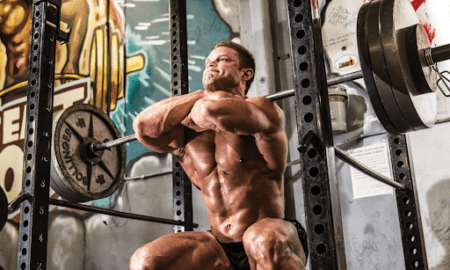Q: Since I’ve been training for a year and consider myself an intermediate, should I follow a five-day split or a split like this: Day 1: chest, biceps; Day 2: legs; Day 3: shoulders; Day 4: rest; Day 5: back, triceps; Day 6: rest; Day 7: cycle begins again with chest and biceps. So I start the next week with the leg workout, and so on?
A: That’s a great question, and I think it’s wise to slowly advance your training program instead of just jumping into an advanced routine. I often see beginners immediately start off with a training program that involves training each muscle group only once a week, and they do four or more exercises per bodypart. That’s for advanced trainees. It’s best to work up to that level instead of starting off with the type of routine you described.
It’s important to develop the foundation of your physique—and the most effective way is to use the basic exercises that incorporate several muscle groups in a coordinated effort to perform the movements. By starting with the basics and gradually getting stronger over time as you use more resistance, you’ll develop a physique with a good foundation and muscle mass.
If you begin a training program with multiple exercises per bodypart—including isolation movements—and lots of sets, you can quickly overtrain the muscles without first developing strength and size. By beginning with a select few exercises that are the most effective for building the body, you can slowly develop your strength and muscle without overtraining.
A typical intermediate program involves training four days a week, hitting each muscle group twice per week. In order to accomplish that, you would need to train your whole body over two workouts. That means training three to four muscle groups at each workout. For example, you could train chest, back, shoulders and calves at one workout and abs, legs, triceps and biceps at the next. Do each workout twice a week for a total of four training days each week.
The next step up from the intermediate program would be to split your body over three workouts instead of two. An example is doing chest and arms on the first day, abs and legs on the second day and shoulders and back on the third day. You can also train chest and back on the first day, abs and legs on the second day and shoulders and arms on the third day.
Which muscle groups you train together depends on your personal preference and what your weak areas are. It’s usually a good idea to train legs by themselves because they’re such a physically demanding muscle group requiring heavy resistance and lots of work.
When you advance to training your body over three days instead of two, you can split it up in a few different ways. You can train three days in a row before taking a day off. That’s called the three-days-on/one-day-off split. You can also schedule a rest day in the middle of the three training days. For example, you can train two days on/one day off/one day on/one day off. Here’s a sample split that uses the extra rest day:
Day 1: Chest, arms
Day 2: Abs, legs
Day 3: Rest
Day 4: Delts, back
Day 5: Rest
Day 6: Cycle begins again
That split gives each muscle group five days of rest before you work it again. If you use the other split, training three days in a row before taking a day off, you will train each muscle group once every four days.
As you get stronger and use more resistance, you will need more rest days before training each muscle group again. That’s because you will be doing more damage to the muscles, which necessitates more recovery. You will also be stressing the body as a whole more because the nervous system will need more days of rest following a heavy weight-training session.
I was training four days a week for a few years when I was bulking up and trying to increase my bodyweight. That was a very hard program to follow because I was training legs with back and biceps. Using exercises like squats, leg presses, stiff-legged deadlifts, barbell rows, T-bar rows and deadlifts all in one training session was extremely exhausting.
When I began training my body over three days instead of two, I was able to have more effective workouts because I was training legs by themselves. That enabled me to put more into each workout without having to do so many basic mass-building exercises.
I started with the three-days-on/one-day-off split. After following that for about a year, I added another rest day after my leg training workout. That gave me another added day before I trained a muscle group again. Instead of training each muscle group every four days, I was training it every five days.
Eventually, I split up my training routine over four days instead of three. Now I was training chest, triceps and calves on the first day, abs and legs on the second, shoulders and calves on the third and back and biceps on the fourth.
If I trained four days on/one day off, it would be five days of rest before I trained a muscle group again. That four-day split gave me more energy to train muscle groups that were weaker instead of combining them with other muscle groups. Eventually, I added a rest day in the middle of that split so my routine looked like this:
Day 1: Chest, triceps, calves
Day 2: Abs, legs
Day 3: Rest
Day 4: Shoulders, calves
Day 5: Back, biceps
Day 6: Rest
The important point to remember about training splits is that it should be a gradual progression. You need to build the muscle and strength by using shorter training sessions focusing on the basic exercises with the goal being to use increasingly heavier resistance. As you become more advanced—bigger and stronger—you can begin to split up the workouts more, as that will give you more rest between sessions for each muscle group as well as shorter workouts so you can train each muscle with more sets and intensity.
Editor’s note: John Hansen has won the Mr. Natural Olympia and is a two-time Natural Mr. Universe winner. Check out his Web site at www
.NaturalOlympia.com for more information about how you can be a part of his exciting, new Natural Olympia Fitness getaway. Send questions or comments to [email protected]. Look for John’s DVD, “Natural Bodybuilding Seminar and Competitions,” along with his book, Natural Bodybuilding, and his training DVD, “Real Muscle,” at his Web site or at Home Gym Warehouse, www.Home-Gym.com. Listen to John’s radio show, “Natural Bodybuilding Radio,” at NaturalBodybuildingRadio.com. IM




















You must be logged in to post a comment Login